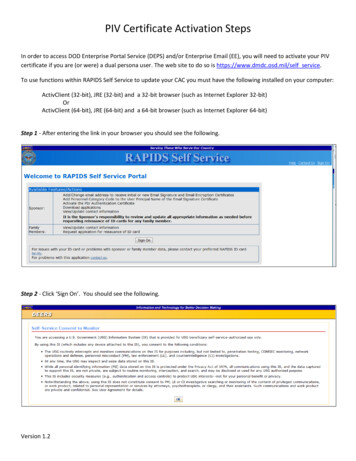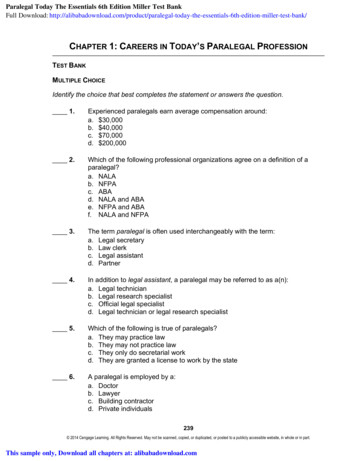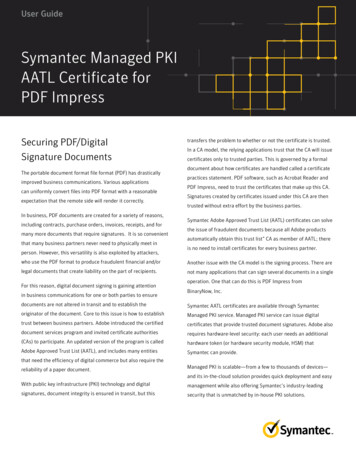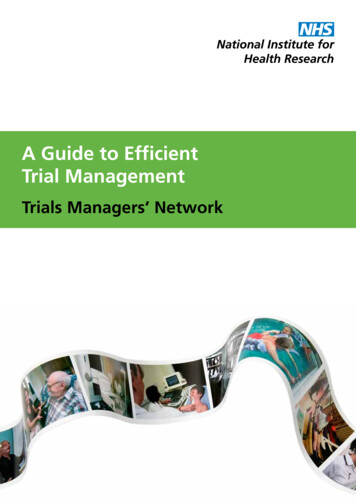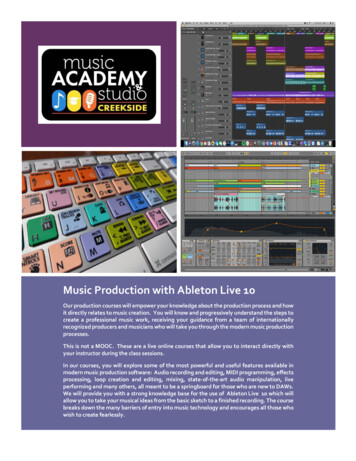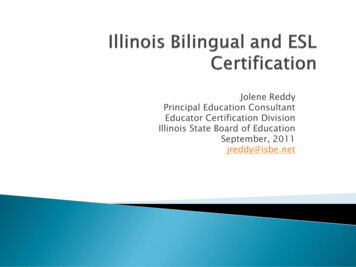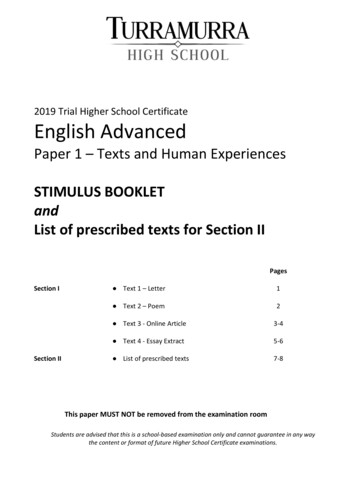
Transcription
2019 Trial Higher School CertificateEnglish AdvancedPaper 1 – Texts and Human ExperiencesSTIMULUS BOOKLETandList of prescribed texts for Section IIPagesSection ISection II Text 1 – Letter1 Text 2 – Poem2 Text 3 - Online Article3-4 Text 4 - Essay Extract5-6 List of prescribed texts7-8This paper MUST NOT be removed from the examination roomStudents are advised that this is a school-based examination only and cannot guarantee in any waythe content or format of future Higher School Certificate examinations.
Section IText 1 – Letter–2–
Text 2 – Poembloodlinesi hail from heat, heatin the heart and in the home, in the head and in the heel of thesword that swings for both justice and action.i inherit this love, this life and these virtues like heirlooms.i inherit this boldness from youi inherit the air of a highborn lady, while not without the humility of a low born daughter fromyoui inherit gentle hands of craft into fists of rage and fire that melt away sorrows from youi rise and fall, for from youi breathe.unspoken it was passed down, and yet it stirs and whispers to me in my bones ofancient thought and force,passed down from kin to kin, from one blood to another oftemperance and willthat flow like tradition—a book written on age-old sandstone pressed eons below the earth,text mapped in bloodlines over a body, not alone. never fading.you bid me to rise from dust and ashes into the woman of your forging,and so with a kiss between my brow forfarewell and fortunei may live with your light tucked into my heart,because my inheritance lives within me.veritas Jul 2018–3–
Text 3 – Online ArticleHow African American folklore saved thecultural memory and history of slavesOctober 9, 2018 Jennifer Dos Reis Dos Santos, Aberystwyth UniversityAll over the world, community stories, customs and beliefs have been passed down fromgeneration to generation. This folkore is used by elders to teach family and friends about theircollective cultural past. And for African Americans, folklore has played a particularly importantpart in documenting history too.The year 1619 marked the beginning of African American history, with the arrival of the firstslave ship in Jamestown, Virginia. Slavery put African Americans not only in physical shackles.They were prevented from gaining any type of knowledge, including learning to read or writeduring their enslavement. Illiteracy was a means to keep control as it was believed thatintellectual stimulation would give African Americans ideas of freedom and independence.The effects of slavery on African culture were huge. The slaves had to forsake their true natureto become servants to Anglo Americans. And yet, even though they were forbidden frompracticing anything that related to their African culture and heritage, the native Africans kept itand their languages alive in America.One important way of doing this was through folk tales, which the African slaves used as a wayof recording their experiences. These stories were retold in secret, with elements adapted totheir enslaved situation, adding in elements of freedom and hope. In the story of a slave fromGuinea, recorded in The Annotated African American Folktales, he asks his white master to buryhim face down when he dies, so that he may return to his home country which he believes isdirectly on the other side of the world:Adapting the oral storytelling traditions of their ancestors helped slaves stolen from West Africacope with and record their experiences in America. And later it helped other generations,particularly in the 19th century, to learn what happened to the ancestors who had beenenslaved.(Text 3 continues on the next page)–4–
–5–
Text 3 continuedFolklore and genealogyFolklore has not just helped African Americans to record and remember large-scale events, orrelate morals as other folk tales do – it has helped with individual family genealogy too.Having an aspect of genealogy in folklore makes African American history not only traceable butmore approachable. The stories relate to specific people, their experiences and the placeswhere they lived. They are not necessarily mythical tales, but stories are about real people andwhat happened to them. They demonstrate and track the fight for freedom and independence.This linking of genealogy and folklore gives the oral histories continuity, and adds an element ofpersonal curiosity to the historical past. Family history figures in many folk tales makes eachstory unique, as one’s own heritage will be intertwined with its telling. It adds to culturalmemory, too, and enhances family values as descendants are able to refer back to and honourtheir ancestors’ experiences.In more recent decades, novels and book retellings of this family history have become the newway of keeping African American folklore alive. Indeed, folklore has been the inspiration behindsome of the most important African American literary works. In Roots, Alex Haley’s work ofhistorical family fiction, the main character’s father, Omoro Kinte, initiates a baptism ritual thathas been transmitted throughout generations. The newborn baby is held up towards the starrynight sky and then given its name. The baby is told to “behold the only thing greater thanyourself”. This naming ritual is a poetic moment and has become iconic in various ways. It iseven referenced in Disney’s The Lion King when Rifiki lifts Simba to the sky.For any one of us, the past is important in determining our identity and history, but without thedetermination and persistence of the first African Americans, it is likely that much of their storywould have been lost to time. Thanks to their repeated sacrifices, African Americans can stilllook to their ancestors for guidance today.–6–
Text 4 – Essay ExtractSilence and powerlessness go hand in hand– women’s voices must be heardRebecca SolnitBeing unable to tell your story is a living death. The right to speak is a form of wealth that isbeing redistributed.Wed 8 Mar 2017 17.00 AEDTIllustration by Nathalie LeesSilence is golden, or so I was told when I was young. Later, everything changed. Silence equalsdeath Silence is the ocean of the unsaid, the unspeakable, the repressed, the erased, theunheard. It surrounds the scattered islands made up of those allowed to speak and of what canbe said and who listens.The quiet of the listener makes room for the speech of others, like the quiet of the reader takingin words on the page, like the white of the paper taking ink. “We are volcanoes,” Ursula Le Guinonce remarked. “When we women offer our experience as our truth, as human truth, all themaps change. There are new mountains.” The new voices that are undersea volcanoes erupt inwhat was mistaken for open water, and new islands are born; it’s a furious business and astartling one. The world changes. Silence is what allows people to suffer without recourse, whatallows hypocrisies and lies to grow and flourish, crimes to go unpunished. If our voices areessential aspects of our humanity, to be rendered voiceless is to be dehumanised or excludedfrom one’s humanity. And the history of silence is central to women’s history.Words bring us together, and silence separates us, leaves us bereft of the help or solidarity orjust communion that speech can solicit or elicit. Some species of trees spread root systemsunderground that interconnect the individual trunks and weave the individual trees into a morestable whole that can’t so easily be blown down in the wind. Stories and conversations are likethose roots.Being unable to tell your story is a living death, and sometimes a literal one. If no one listenswhen you say your ex-husband is trying to kill you, if no one believes you when you say you arein pain, if no one hears you when you say help, if you don’t dare say help, if you have beentrained not to bother people by saying help. If you are considered to be out of line when youspeak up in a meeting, are not admitted into an institution of power, are subject to irrelevantcriticism whose subtext is that women should not be here or heard.[Text 4 continues on the next page]–7–
Text 4 continuedStories save your life. And stories are your life. We are our stories; stories that can be bothprison and the crowbar to break open the door of that prison. We make stories to saveourselves or to trap ourselves or others – stories that lift us up or smash us against the stonewall of our own limits and fears. Liberation is always in part a storytelling process: breakingstories, breaking silences, making new stories. A free person tells her own story. A valuedperson lives in a society in which her story has a place.By voice, I don’t mean only literal voice – the sound produced by the vocal cords in the ears ofothers – but the ability to speak up, to participate, to experience oneself and be experienced asa free person with rights. This includes the right not to speak, whether it’s the right againstbeing tortured to confess, as political prisoners are, or not to be expected to service strangerswho approach you, as some men do to young women, demanding attention and flattery andpunishing their absence.If the right to speak, if having credibility, if being heard is a kind of wealth, that wealth is nowbeing redistributed. There has long been an elite with audibility and credibility, and anunderclass of the voiceless.Who is heard and who is not defines the status quo. Those who embody it, often at the cost ofextraordinary silences with themselves, move to the centre; those who embody what is notheard, or what violates those who rise on silence, are cast out.By redefining whose voice is valued, we redefine our society and its values.This essay is an extract from Rebecca Solnit’s new book, The Mother of All Questions–8–
Section IISection IIThe prescribed texts for Section II are: Prose Fiction– Anthony Doerr, All the Light We Cannot See– Amanda Lohrey, Vertigo– George Orwell, Nineteen Eighty-Four– Favel Parrett, Past the Shallows Poetry– Rosemary Dobson, Rosemary Dobson CollectedThe prescribed poems are:* Young Girl at a Window* Over the Hill* Summer's End* The Conversation* Cock Crow* Amy Caroline* Canberra Morning– Kenneth Slessor, Selected PoemsThe prescribed poems are: DramaContemporary******Wild GrapesGulliverOut of TimeVesper-Song of the Reverend Samuel MarsdenWilliam StreetBeach Burial– Jane Harrison, Rainbow's End, from Vivienne Cleven et al.,Indigenous Plays– Arthur Miller, The Crucible– William Shakespeare, The Merchant of Venice Nonfiction– Tim Winton, The Boy Behind the CurtainThe prescribed chapters are:*******Havoc, A Life in AccidentsBetsyTwice on SundaysThe Wait and the FlowIn the Shadow of the HospitalThe Demon SharkBarefoot in the Temple of Art– Malala Yousafzai and Christina Lamb, I am MalalaSection II continues on the next page–9–
Section II continued Film Media– Stephen Daldry, Billy Elliot– Ivan O'Mahoney, Go Back to Where You Came FromThe prescribed episodes are:*Series 1: Episodes 1, 2 and 3and* The Response– Lucy Walker, Waste LandEnd of Section II– 10 –
Student Number2019 Trial Higher School CertificateEnglish AdvancedPaper 1 – Texts and Human ExperiencesGeneralInstructions Reading time – 10 minutesWorking time – 1 hour 30 minutesWrite using black penA Stimulus Booklet is provided with this paperWrite your Student Number at the top of this page andpages 2, 4, 6 and 8.Total marks:40Section I – 20 marks (pages 1–9) Attempt Questions 1–5 Allow about 45 minutes for this sectionSection II – 20 marks (page 10) Attempt Question 6 Allow about 45 minutes for this sectionThis paper MUST NOT be removed from the examination roomStudents are advised that this is a school-based examination only and cannot guarantee in any waythe content or format of future Higher School Certificate examinations.
Section I20 marksAttempt Questions 1–5Allow about 45 minutes for this sectionRead the texts on pages 1–6 of the Stimulus Booklet carefully and then answer the questions inthe spaces provided. These spaces provide guidance for the expected length of response.If you require extra space for a response, additional paper is available.Your answer will be assessed on how well you: demonstrate understanding of human experiences in texts analyse, explain and assess the ways human experiences are represented in textsQuestion 1 (3 marks)Use Text 1 to answer this question.How does Text 1 provide insight into the human qualities and emotions associated withgrief? –2–
Section I continues on page 3–3–
Student Number2019 Trial Higher School CertificateEnglish AdvancedPaper 1 – Texts and Human ExperiencesSection I (continued)Attempt Question 2Answer the question in the space provided. This space provides guidance for the expectedlength of response. If you require extra space for a response, additional paper is available.Please turn over–4–
Section I (continued)Question 2 (3 marks)Use Text 2 to answer this question.Explain how the poet's use of language conveys their personal reflection on the role of family informing identity. –5–
Section I continues on page 5Student Number2019 Trial Higher School CertificateEnglish Advanced–6–
Paper 1 – Texts and Human ExperiencesSection I (continued)Attempt Question 3Answer the question in the space provided. This space provides guidance for the expectedlength of response. If you require extra space for a response, additional paper is available.Please turn over–7–
Section I (continued)Question 3 (4 marks)Use Text 3 to answer this question.How does Text 3 represent the significance of individual and collective cultural experience? Section I continues on page 7–8–
Student Number2019 Trial Higher School CertificateEnglish AdvancedPaper 1 – Texts and Human ExperiencesSection I (continued)Attempt Question 4Answer the question in the space provided. This space provides guidance for the expectedlength of response. If you require extra space for a response, additional paper is available.Please turn over–9–
Section I (continued)Question 4 (4 marks)Use Text 4 to answer this question.Analyse some of the ways in which Text 4 values voices to challenge or ignite ideas. Section I continues on page 9– 10 –
Student Number2019 Trial Higher School CertificateEnglish AdvancedPaper 1 – Texts and Human ExperiencesSection I (continued)Attempt Question 5Answer the question in the space provided. This space provides guidance for the expectedlength of response. If you require extra space for a response, additional paper is available.Please turn over– 11 –
Section I (continued)Question 5 (6 marks)Use Texts 2 and 4 to answer this question.Compare how the composers of Texts 2 and 4 explore shared human experiences. – 12 –
End of Section I, Paper 1– 13 –
Section II20 marksAttempt Question 6Allow about 45 minutes for this sectionAnswer the question in a SEPARATE Writing Booklet. Extra writing booklets are available.Your answer will be assessed on how well you: demonstrate understanding of human experiences in texts analyse, explain and assess the ways human experiences are represented in texts organise, develop and express ideas using language appropriate to audience, purpose andcontextQuestion 6 (20 marks)Texts are a reflection of human qualities and emotions that arise from shared experiences.Explore this statement with close reference to your prescribed text.The prescribed texts are listed on pages 7 – 8 of the Stimulus Booklet.End of paper– 14 –
2019 Trial Higher School CertificateEnglish AdvancedPaper 2 – ModulesGeneralInstructions Reading time – 5 minutes Working time – 2 hours Write using black penTotal marks:60Section I – 20 marks (pages 2–4) Attempt ONE question from Questions 1–7 Allow about 40 minutes for this sectionSection II – 20 marks (pages 5–8) Attempt ONE question from Questions 8–14 Allow about 40 minutes for this sectionSection III – 20 marks (pages 9–10) Attempt Question 15 Allow about 40 minutes for this sectionThis paper MUST NOT be removed from the examination roomStudents are advised that this is a school-based examination only and cannot guarantee in any waythe content or format of future Higher School Certificate examinations.
Section I — Module A: Textual Conversations20 marksAttempt ONE question from Questions 1–7Allow about 40 minutes for this sectionAnswer the question in the writing booklet provided. Extra writing booklets are available.Your answer will be assessed on how well you: demonstrate understanding of how composers are influenced by another text's concepts andvalues evaluate the relationships between texts and contexts organise, develop and express ideas using language appropriate to audience, purpose andformQuestion 1 — Shakespearean Drama and Film (20 marks)Never again will a single story be told as though it is the only one.– John BergerTo what extent is this statement true in the light of your exploration of Textual Conversations?In your response, make close reference to the pair of prescribed texts that you have studied inModule A.The prescribed texts are:– William Shakespeare, King Richard IIIand– Al Pacino, Looking for RichardQuestion 2 — Prose Fiction and Film (20 marks)You have studied a pair of prescribed texts in Textual Conversations.How has the context of each text influenced your understanding of the intentional connectionsbetween them?The prescribed texts are:– Virginia Woolf, Mrs Dallowayand– Stephen Daldry, The Hours–2–
Question 3 — Prose Fiction and Prose Fiction(20 marks)Never again will a single story be told as though it is the only one.– John BergerTo what extent is this statement true in the light of your exploration of Textual Conversations?In your response, make close reference to the pair of prescribed texts that you have studied inModule A.The prescribed texts are:– Albert Camus, The Strangerand– Kamel Daoud, The Meursault InvestigationQuestion 4 – Poetry and Drama (20 marks)You have studied a pair of prescribed texts in Textual Conversations.How has the context of each text influenced your understanding of the intentional connectionsbetween them?The prescribed texts are:– John Donne, John Donne: A Selection of His PoetryThe prescribed poems are:********The Sunne RisingThe ApparitionA Valediction: forbidding mourningThis is my playes last sceneAt the round earths imagin'd cornersIf poisonous mineralsDeath be not proudHymne to God my God, in my sickenesseand– Margaret Edson, W;t–3–
Question 5 — Poetry and Film(20 marks)Never again will a single story be told as though it is the only one.– John BergerTo what extent is this statement true in the light of your exploration of Textual Conversations?In your response, make close reference to the pair of prescribed texts that you have studied inModule A.The prescribed texts are:– John Keats, The Complete PoemsThe prescribed poems are:*******La Belle Dame sans MerciTo AutumnBright star! would I were steadfast as thou artOde to a NightingaleOde on a Grecian UrnWhen I have fears that I may cease to beThe Eve of St Agnes, XXIIIand– Jane Campion, Bright Star–4–
Question 6 – Poetry and Poetry (20 marks)You have studied a pair of prescribed texts in Textual Conversations.How has the context of each text influenced your understanding of the intentional connectionsbetween them?The prescribed texts are:– Sylvia Plath, ArielThe prescribed poems are:******DaddyNick and the CandlestickA Birthday PresentLady LazarusFever 103oThe Arrival of the Bee Boxand– Ted Hughes, Birthday LettersThe prescribed poems are:******Fulbright ScholarsThe ShotA Picture of OttoFeverRedThe Bee GodQuestion 7 – Shakespearean Drama and Prose Fiction (20 marks)"Imprisonment of the body is bitter; imprisonment of the mind is worse."– Thornton WilderTo what extent do you agree with this statement?In your response, refer to your two prescribed texts.The prescribed texts are:– William Shakespeare, The Tempestand– Margaret Atwood, Hag-Seed–5–
Section II — Module B: Critical Study of Literature20 marksAttempt ONE question from Questions 8–14Allow about 40 minutes for this sectionAnswer the question in the writing booklet provided. Extra writing booklets are available.Your answer will be assessed on how well you: demonstrate an informed understanding of the ideas expressed in the text evaluate the text's distinctive language and stylistic qualities organise, develop and express ideas using language appropriate to audience, purpose andformQuestion 8 – Prose Fiction (20 marks)(a)Jane Austen, EmmaSeldom, very seldom, does complete truth belong to any human disclosure; seldom can ithappen that something is not a little disguised, or a little mistaken.– Jane Austen, EmmaHow do misunderstandings in Jane Austen's Emma function as a narrative device?In your response, refer to the quotation and your understanding of the novel, Emma.OR(b)Charles Dickens, Great Expectations'While there is evil in the world of Great Expectations, there is also the possibility ofredemption.'To what extent does this statement relate to your own understanding of your prescribedtext?In your response, refer to the quotation and the novel, Great Expectations.OR(c)Kazuo Ishiguro, An Artist of the Floating WorldIn what ways is An Artist of the Floating World a novel about the shifting relationshipbetween an individual and his nation?In your response, refer to the novel, An Artist of the Floating World.–6–
Question 9 – Poetry (20 marks)(a)T S Eliot, T S Eliot: Selected PoemsHow does T S Eliot use setting to portray central concerns in his poetry?In your response, you must make detailed reference to at least TWO of the poems set forstudy.The prescribed poems are:– T S Eliot, T S Eliot: Selected PoemsThe prescribed poems are:*****The Love Song of J Alfred PrufrockPreludesRhapsody on a Windy NightThe Hollow MenJourney of the MagiOR(b)David Malouf, Earth HourLiterature cannot be appreciated without empathy and without acknowledginguncomfortable truths.To what extent does this statement apply to your prescribed text?The prescribed poems are:– David Malouf, Earth HourThe prescribed poems are:********AquariusRadianceLadybirdA Recollection of Starlings: Rome '84Eternal Moment at Poggia MadonnaTowards MidnightEarth HourAquarius II–7–
Question 10 – Drama (20 marks)(a)Henrik Ibsen, A Doll's HouseHow does A Doll's House use the conventions of its form to question societal values?In your response, refer to the play, A Doll's House.OR(b)Dylan Thomas, Under Milk WoodHow does Under Milk Wood's structure allow it to convey complex themes?In your response, refer to the play, Under Milk Wood.Question 11 – Nonfiction (20 marks)(a)Edmund de Waal, The Hare with Amber EyesFor what purposes does The Hare with Amber Eyes manipulate the conventions of itsform?In your response, refer to your understanding of the memoir, The Hare with Amber Eyes.OR(b)Vladimir Nabokov, Speak, MemoryTo what extent is Speak, Memory an exploration of the complexities of nostalgia?In your response, refer to your understanding of the nonfiction text, Speak, Memory.–8–
Question 12 – Film – George Clooney, Good Night, and Good Luck (20 marks)How do the unique textual features of Good Night, and Good Luck allow it present its keythemes?In your response, refer to your understanding of the film, Good Night, and Good Luck.Question 13 – Media – Gillian Armstrong, Unfolding Florence (20 marks)How does Unfolding Florence use the conventions of its form to question assumptions aboutgender?In your response, refer to the documentary, Unfolding Florence.Question 14 – Shakespearean Drama – William Shakespeare, King Henry IV, Part 1 (20 marks)Falstaff has been labelled as one of 'nature's predators'.Write an extended response in which you challenge or affirm this view regarding Falstaff inShakespeare's King Henry IV, Part 1.–9–
Section III — Module C: The Craft of Writing20 marksAttempt Question 15Allow about 40 minutes for this sectionAnswer the question in the writing booklet provided. Extra writing booklets are available.Your answer will be assessed on how well you: craft language to address the demands of the question use language appropriate to audience, purpose and context to deliberately shape meaningQuestion 15 (20 marks)(a)'After all, our lives are but a sequence of accidents – a clanking chain of chance events.A string of choices, casual or deliberate, which add up to that one big calamity we call life.'– Rohinton MistryUse the above stimulus to compose an imaginative, discursive or persuasive piece thatcaptures a significant moment in an individual's life.10In your response, you must include at least ONE literary device or stylistic feature that youhave explored during your study of a prescribed text in Module C.(b)Explain how at least ONE of your prescribed texts from Module C has influenced yourwriting style in part (a).In your response, focus on ONE
some of the most important African American literary works. In Roots, Alex Haley [s work of historical family fiction, the main character [s father, Omoro Kinte, initiates a baptism ritual that has been transmitted throughout generations. The newborn baby is held


